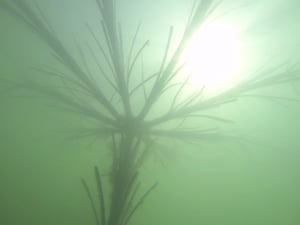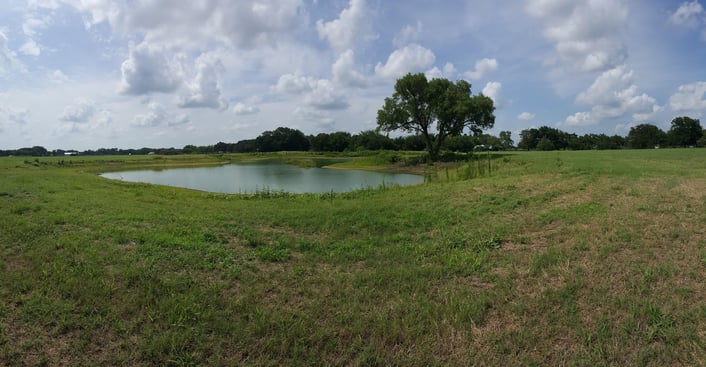There is no such thing as a "healthy" or "unhealthy" pond.
Each pond has its own specific ecosystem, so a better question is, "what is the condition of my pond ecosystem?" or "how healthy is my pond?"
Here's how to find out.
The Myth of Pond Health
Customers often ask, "Is my pond healthy?" or "How do I know if my pond is healthy?" and the honest answer is there is no such thing as a "healthy" or "unhealthy" pond.
Each pond has its own specific ecosystem, and these ecosystems often vary depending on several factors such as ecoregion, available habitat, watershed size, or substrate composition, just to name a few.
It is because of these variances that there is no clear definition for a "healthy" pond. Perhaps a better question would be, "what is the condition of my pond ecosystem?" or "is my pond ecosystem conducive to fish production/growth?" These questions can be answered by water quality testing, habitat analysis, and electrofishing surveys.
Step 1: Test Water Quality
A water quality test will tell you a lot about your pond's condition. We can test your sample right here at Pond King, or you can send it off to a lab such as the Texas A&M Agrilife Extension Soil, Water, and Forage Testing Laboratory for a more detailed report.
What Do Biologists Look for In a Pond Water Quality Test?
The 3 main things we look for in our water quality test are pH, Alkalinity, and Total Hardness. Optimal pH levels are 6.5 - 9; however, fish can still survive well outside this range. Alkalinity is the water's ability to buffer pH swings and is measured in mg/L CaCO3. The optimal range for Alkalinity is 65 -150 mg/L CaCO3. Total Hardness refers to the quantity of divalent ions (Calcium, Magnesium, and Iron) and is measured in mg/L CaCO3. Not to be confused with Alkalinity as they are measured in the same units.
Total Hardness is important because calcium is critical in the formation of bone structures as fish grow. Total Hardness of 100 - 250 mg/L CaCO3 is optimal. If your test reveals numbers outside of these ranges, don't worry because these issues can often be resolved by treating with gypsum or limestone.
How to Collect Water Samples for Testing
When taking water samples, do not take water directly off the surface. Instead, turn the water bottle upside down, so the trapped air prevents water from entering the bottle. Push the bottle down about 6 inches beneath the surface, then turn the bottle on its side, allowing the air to escape, and water to fill the bottle.
One full water bottle is sufficient for most testing purposes.
Step 2: Habitat Analysis

The purpose of Habitat Analysis is to verify there is sufficient habitat in and around the pond for fish utilization and erosion control. This step simply requires a look at the pond and its immediate surroundings.
Since all fish require cover for different reasons at different life stages and seasons, it is important to determine if there is adequate habitat for fish utilization. But this assessment can be a little tricky. What you'll need to do is estimate the amount of surface area covered with habitat.
How Much Habitat is Needed for Fish?
We recommend habitat covering 10 - 15% of the total surface area of the lake. If you have less than that, you'll need to add more.
Whether you have enough or not, you also need to think about where the habitat is located.
Where Should Habitat be Placed in a Lake?
Habitat located at various depths throughout the water column is essential to providing cover for fish to utilize throughout their seasonal transitions (See our habitat infographic for more on this).
This can be achieved with natural hardwoods or cedars or the use of artificial habitat, such as the Pond King line of habitat. Nursery habitat for fry and juvenile fish is critical for recruitment to ensure sustainable populations of fish.
This can be grasses, bushes, or reeds in or near protected shallow pockets that give the small fish a place to evade predation, reducing their mortality rates.

Controlling Erosion and the Sedimentation in Your Pond
Erosion control helps prevent groundwater runoff, which reduces excess nutrients from being washed in, and provides soil stability around the pond, preventing sedimentation. Excessive nutrient loading can cause excessive algae blooms and vegetation problems during warm months of the year and can lead to fish kills from oxygen depletion or costly chemical vegetation treatments to regain control.
By increasing soil stability around your pond, you decrease the sedimentation rate and slow your pond's aging process. This is important with new ponds to let the suspended sediment settle out to let the pond clear without always having new dirt washed in.
The same principle applies to ponds that just had a gypsum treatment to clear them, but if more sediment is continuously getting washed in, the gypsum may become irrelevant.
Once you cover these habitat bases, you are set for step 3.
Step 3: Electrofishing Survey
Electrofishing surveys allow biologists to estimate population densities and community samples of what is currently in existing ponds. From the data collected during the survey, we can ensure your populations are balanced between predators and forage at the necessary ratios, ensure age and size classes are balanced within a species population and check on your fish's growth rates by comparing age to their length and weight.
This data guides us as we harvest or stock necessary species to balance the populations and communities within the ecosystem. By maintaining a well-balanced fish population, growth rates, and recruitment rates of all species improve, leading to greater sustainability and better fishing down the road.
You can also watch this video on evaluating your pond’s health to learn more about what you can do to improve your own pond.
Contact Pond King for Electrofishing Surveys!
The fisheries biologists of Pond King are always ready to provide you with more information about stocking private ponds or lakes with both game and forage fish species. Let one of our electrofishing surveys guide you on the right path to a trophy lake!
If you have any questions or are in need of information on private pond fish management, give our team a call or contact us!
See y'all down at the pond.





